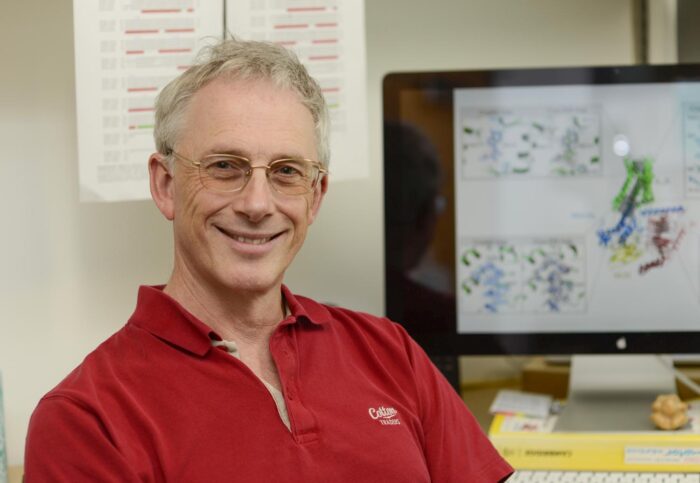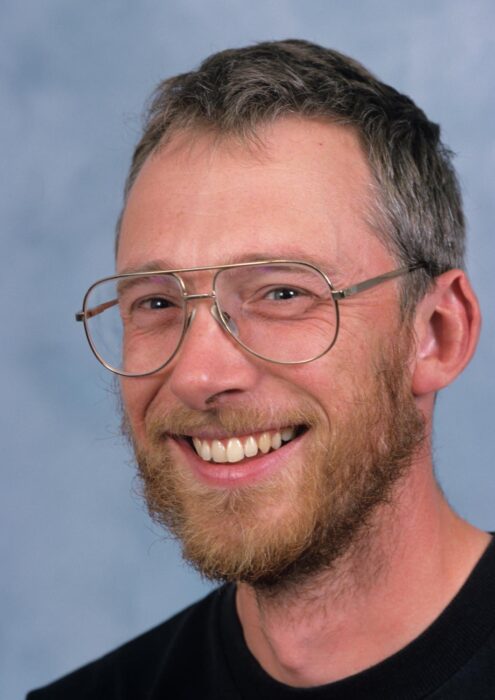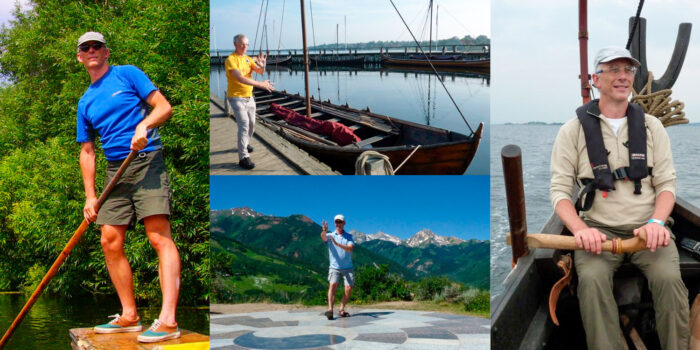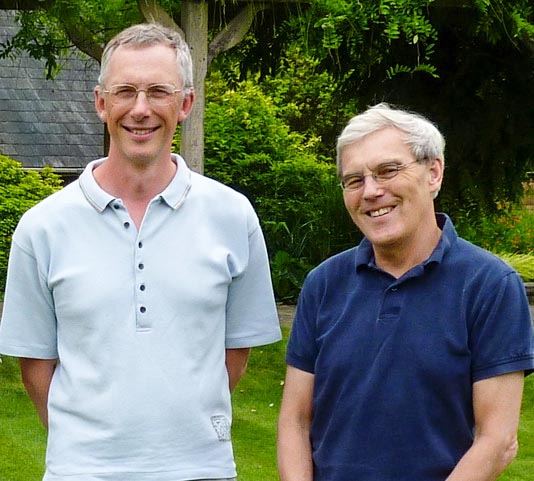From the scientist’s view: a conversation with … Chris Tate

Chris Tate is a Group Leader in the Structural Studies Division at the LMB.
He received an undergraduate degree and PhD in Biochemistry from the University of Bristol. After a postdoctoral placement in the University of Cambridge’s Department of Biochemistry, he joined the LMB in 1992, initially as a researcher in Richard Henderson’s group.
Chris started his own group in 2010, investigating the structure and function of G protein-coupled receptors (GPCRs). These membrane proteins are vital to a variety of processes, such as taste, smell and receiving neurotransmitter and hormonal signals. Their influence over such a wide range of functions means they hold huge therapeutic potential. Structures of GPCRs are now facilitating the development of new drugs with greater specificity and fewer side effects.
We recently talked to Chris about his research and career in science.
What is your earliest memory of science or scientific discovery?
My earliest recollection of a scientific discovery was when I was about four doing an experiment on my spatial perception – how to walk from my bedroom to my parents’ bedroom without seeing. I imagined it, to see if I could do it, then put a pillowcase over my head and started walking with absolute certainty of where to go, went smack into a wall and broke my collarbone. In terms of experiments, it wasn’t very successful, but it taught me a lot about how to actually approach experiments and to perhaps do them a little bit more sensibly.
I remember being at school and doing all sorts of amazing experiments, dissecting rats and locusts and worms – we dissected an earthworm, which was absolutely amazing. I just loved being in the lab. Chemistry was even better, doing chemistry experiments, which I don’t think you can do in schools anymore. We had an amazing chemistry teacher at A-Level, Roger Barnes. He did a PhD in Bristol and he was actually devising the Nuffield course in biochemistry. He was the inspiration for me ending up in biochemistry. We were making phenol oxidase from potatoes and doing biochemical assays, which for a 17-year-old was just fantastic. I really enjoyed it.
What inspired you to choose your particular area of research?
I think the choice of researching membrane proteins started quite early. I remember at A-Level, looking at biological membranes, and actually the structure we were told was entirely wrong, because the fluid mosaic model for membranes hadn’t made it into the textbooks at that time. But it fascinated me how you had this boundary in the cell, but how do things get across it? How do you actually get signalling? Because you can’t have a cell just surrounded like a plastic bag where nothing can go across it. You have to be able to have nutrients going across but also any toxins going out. So there has to be a permeability, but how do you get the specificity of that permeability? In receptors also, how do you get that binding of something on the outside and a dynamic change to lead to signalling on the inside?
And then when I was at Bristol as an undergraduate, we had a final year project and I chose a topic with Mike Tanner, who actually ended up as my PhD supervisor. It was to work on a protein called the calcium magnesium ATPase from red blood cells. Nobody in the lab was working on it, but Mike thought it would be a terribly good idea to have me purify it so we could do the cloning of it. And so basically, he just gave me a paper and said “do this.” And I had so much fun. I mean nobody was doing anything like this. I just ran loose in the lab, and it was wonderful. And I think to everybody’s shock, I got it to work in a few weeks. And they thought, “Ah, now what do we do?” It was just great. And that really cemented my fascination with membrane proteins and I’ve only ever worked on membrane proteins since.
What is the most exciting thing about your work or research?
The excitement you get in this area is ongoing, there are always peaks of excitement. I remember the first time we looked at the projection structure of EmrE, a multi-drug transporter we were working on towards the end of the 1990s. At that stage we were making 2D crystals and using electron crystallography to determine the structure. At the time, it was thought that EmrE was supposed to be a trimer, so four transmembrane helices in a trimer. So, 12 helices with a three-fold axis relating all of them. I looked at the projection structure and it was asymmetric and there was not enough density for 12 helices, there was only enough for eight. It’s just incredible, because having an asymmetric dimer for a homodimer is not possible. Actually, after a lot of research, it was a completely novel topology in the membrane with one N- and C-terminus on the outside and the other on the inside. So, it’s an anti-parallel dimer which hadn’t been seen before. It’s those things which you don’t expect: that’s the real excitement of science.

In March 2005 we started doing the protein engineering on making thermostable receptors. I knew it was going to work, but I never realised how well it was going to work. And then that was a foundation for the company we set up a little bit later called Heptares Therapeutics Ltd.
And then every time you get a structure, each structure is new. The latest structure that we got was the one from Ste2 from Vaithish Velazhahan in the lab. It was just so exciting. There were so many novel things about it: it was the fact it was a dimer; there was the fact that how the ligand bound was unique and how it activated the receptor was unique. How you actually saw those conformational changes going from the ligand to the inside was different. Everything you do when you get a result like that is exciting. And that’s what keeps you going because I can tell you the troughs in between can be quite deep and long sometimes, but you get over it.
Has there been an experiment or piece of work that didn’t go to plan but turned out to have a positive, if unexpected, outcome? What did you learn from it?
An experience which really made a big difference even though most of it never got published, was working on the serotonin transporter, which was the project I initially started in 1992 to try and get a structure. I was basically about 20 years too early. It was actually solved eventually by another group. The problem was that it was a horrible protein; it was very unstable, it required cholesterol for activity, it required N-glycosylation for proper folding, it expressed at very low levels. But what it taught me was a lot about membrane protein overexpression. Everything that we did afterwards, with GPCRs has been based on that.
But also, it was really the foundation for thermostabilisation. Because this was my main project and it was a horrible protein, I couldn’t take it forward. EmrE was my side project, and that was an incredibly stable protein. It planted the seed in my mind of what would happen if I can make the serotonin transporter much, much more stable, just like EmrE. It would make life so much easier. You’ll be able to get a structure. And in the end that was exactly the strategy which was used by another group. I mean, we made thermostable mutants of the serotonin transporter it worked really well. But our crystals only ever diffracted to 7 Å and we needed an antibody which we didn’t have to be able to get the full structure.
So that was something which was hard. To get scooped like that after 20 odd years of work is not nice. But everything that we learned from that has been used for the GPCR work.
What drew you to want to come to LMB and what is special about working here?
The LMB is just an amazing building to work in. Even the old building was amazing to work in, even though it’s not so palatial as the new building. It’s the people here which makes the difference. And when I say the people, it’s not just the scientists. It’s everybody who’s here; all the support scientists, all the people who work in estates, the cleaners, everybody. When I have guests come into the LMB, they’re astounded by both the quality of the building but also how beautifully clean it still is after nearly nine years.
But of course, the best thing about the people is the time they give you. You can have the craziest idea in science, and you can always find somebody to discuss it with and people really give you the time. And the way the LMB has been set up is so that you can do these crazy ideas, that there’s no impediment to doing good science.
And of course, the funding here at the LMB is also magnificent. To be able to have the consumable money to do what you want is also incredible. It’s all these things coming together makes it a wonderful place to work.
The old building was special in its own way. We were packed in there like sardines, so you really met people and you mixed a lot because there were very few boundaries between divisions. I spent a lot of time in a rather grubby tissue culture lab with all the people from PNAC and met some amazing people. That mixing is so important; the sharing of ideas. I remember once I was up in the canteen in the old building, and a PhD student from David Neuhaus’ group came along. We were chatting about his research, and he suddenly mentioned “Oh, and then I just ligated this peptide onto the end of my protein.” And then I say, “Wait, what! How do you do that?” Because that was exactly what I was looking for, to help with a project. It ended up being one of our major publications, getting a structure of the arrestin bound to the beta-adrenergic receptor. So, these chance conversations are amazing.
And I have lovely memories of talking with Max Perutz up in the canteen. He was so lovely to talk to and he just wanted to know about your science. Now, he wouldn’t want to talk about himself or his science. He just wanted to talk about your science. And these things, that’s what makes the LMB so special.
What do you think makes a good scientist?
You’ve got to be absolutely driven, pedantic about your science. But then you mustn’t be driven so much that you don’t listen to other people and try other things. You’ve got to be open to new ideas, but then you’ve got to be determined to make this idea work. It’s a strange mixture of things. Dedication, definitely. You just have to put the time in. You’ve got to work hard. You’ve also got to think hard. And then you’ve also got to play hard because just being stuck in the lab 24/7 is not enough. All the best thoughts I have ever had have not been in the lab. Because when you’re in the lab, you’re thinking, you’re working. You’re focusing on what’s in front of you. But if you want to think sideways, you have to get out of the lab and do other things. Whether it’s sailing, walking, cycling, or doing tai chi, anything that relaxes your mind and then allows it to think laterally is so important.
What is your favourite thing to do away from science?
I have lots of favourite things to do away from science. I’ve been doing tai chi for the last 23 years. I’m a tai chi instructor which helps me to relax and to meet other people outside science, which is lovely. I used to be a sailing instructor, I did a lot of sailing, did cruising on the broads, sailed over the North Sea to Holland. I did a lot of cycling, I cycled from Land’s End to John O’Groats. I love hill walking in the mountains in Switzerland. I’ve done the walkers Haute Route from Chamonix to Zermatt and the Tour de Mont Blanc. Fantastic being outside. What more could you want?

Who has been the biggest influence on your life or scientific career and how has their work influenced you or made your research possible?
Throughout my career, I’ve had lots of people who have influenced me and helped me along my way as a scientist. I’ve already mentioned the first person who was my chemistry teacher, Roger Barnes who was an amazing scientist.
And then in my first real lab experience, being in the lab with Mike Tanner, both as an undergraduate and then as a PhD student. He taught me how to make hard decisions. I remember halfway through my PhD, I was trying to isolate a cDNA clone for the calcium magnesium ATPase using lgt11 expression cloning, which was the only method which has never ever given rise to a cDNA clone using an antibody for membrane proteins. So, the method was at fault, not me. But you don’t see that at the time. About halfway through my PhD, Mike came to me one morning and said, “Chris, I really think you ought to change project, this is not going to work.” The instantaneous feeling is just anger. I’ve worked really hard for a year and a half, and now you’re telling me to change. I sat and thought about it for a few days and thought, “Well who knows more about science? Me as a PhD student or him as my supervisor?” So, I went and had a chat with him, changed project and ended up with three first-author papers from it in the last year and a half. So, taking advice is important. Making difficult decisions is really, really important. And knowing when to terminate a bad project is critical.
Later on, I moved to Biochemistry in Cambridge, and there, Peter Henderson taught me the importance of being pedantic and the discipline of numbers in terms of radioligand binding assays, these are transport assays as well. And all the radioactive work we’ve done has been based on that. It’s just wonderful, it really gives you good insights into the activities of your proteins.

And then I suppose my biggest influence has been Richard Henderson, since I’ve been at the LMB. He’s an amazing guy, he’s so enthusiastic, always got some advice, always open for a chat and to discuss science, although you do have to be very careful. If you come along for a 10 or 15-minute chat, you normally have to allow about two hours because we always get diverted and talk about other things. He’s also been very, very kind in giving me difficult advice as well. A number of years down the line, when I still hadn’t got a structure, he did pointedly tell me that I “could only show promise for a certain window of time, and then you have to produce”. I took that as the writing on the wall that I had to do something. The advice doesn’t have to be nice, but it can be timely. Richard has always given very good advice, so that’s been very helpful.
Chris was interviewed for the LMB Alumni Newsletter on 19th October 2022